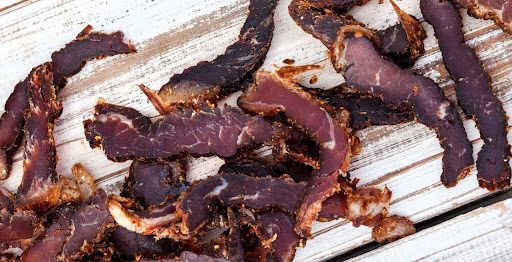The World of Biltong a Guide to Types and Flavours

A brief overview of the various types of biltong, including different meats used, flavours available, health benefits, cultural significance, and how to make it at home.
Biltong stands as a quintessential South African delicacy, embodying a long-standing tradition of meat preservation that has been passed down through generations. Originating in Southern Africa, this savoury treat is more than just a snack; it is a cultural icon, deeply intertwined with the region’s culinary heritage. The process of making biltong begins with slicing meat, traditionally beef, into strips or “tongues,” a practice that is reflected in its name derived from Dutch words ‘bil’ (buttock) and ‘tong’ (strip or tongue). This method of preparation highlights the historical significance and the artisanal approach to creating biltong, ensuring each piece retains its robust flavour and texture.
The preservation of biltong employs a carefully curated blend of salt, vinegar, and spices, all chosen for their antimicrobial properties, which allows the meat to be cured and dried without losing its nutritional value. This technique, honed over centuries, was born out of necessity for preserving meat in the harsh climates of Southern Africa, where refrigeration was not an option. Today, biltong remains a popular snack not only for its taste but also for its high protein content and health benefits. It’s a testament to the ingenuity of early South African settlers, blending culinary skill with the need for sustenance in a challenging environment. The art of biltong making, while rooted in ancient practices, continues to evolve, embracing new flavours and meats, yet always staying true to the original process that has made biltong a beloved snack around the world.
Types of Meat Used in Biltong
The diversity in biltong extends beyond its traditional beef base to include a variety of meats, each contributing its own unique flavour and texture to the delicacy. Ostrich biltong is a notable alternative, prized for its leaner meat and distinctive taste profile. The lower fat content of ostrich meat not only offers a healthier option but also imparts a subtle, gamey flavour that is markedly different from beef, making it a favoured choice among health-conscious consumers and those looking to explore exotic tastes.
In addition to ostrich, the realm of biltong also embraces the rich flavours of game meats, such as venison. Game biltong captures the essence of the wild, delivering a robust and earthy taste that is deeply rooted in the heritage of South African cuisine. This type of biltong, with its deep flavors and cultural significance, appeals to aficionados of traditional and authentic culinary experiences. For individuals following plant-based diets or those simply seeking a vegetarian snack option, mushroom biltong emerges as an innovative alternative. Crafted to mimic the chewy texture and complex flavours of meat-based biltong, mushroom biltong stands as a testament to the adaptability of this snack, offering a wholesome and satisfying option without compromising on taste or texture.
Variety in Biltong Flavours
The spectrum of biltong flavours showcases a remarkable versatility, moving well past the conventional into a realm where the adventurousness of culinary experimentation shines. For those with a penchant for heat, chilli biltong presents an irresistible option, adding layers of spice that not only intensify the inherent taste of the meat but also provide a lingering warmth that spice aficionados appreciate. This spicy variant is particularly popular among those looking to add an extra dimension to their snacking experience.
In contrast, garlic biltong emerges as a favourite for those who prefer their flavours rich and aromatic. The addition of garlic introduces a depth of flavour that complements the meat’s natural taste, creating a harmonious blend that is both bold and inviting. This flavourful option exemplifies the culinary creativity inherent in biltong production, illustrating how a simple meat snack can be transformed into a gourmet delicacy. Furthermore, the exploration of flavours such as garlic and chilli highlights the adaptability of biltong, making it a versatile snack that can be customised to suit a wide array of taste preferences.
Health Benefits and Nutritional Value
Biltong emerges as a standout snack in the realm of health and nutrition, primarily due to its impressive protein content. High-quality protein is essential for muscle repair, growth, and overall body health, and biltong provides this in abundance. The unique drying and curing process not only extends the shelf life of the meat but also preserves its nutritional integrity, ensuring that a significant portion of the protein content is retained. This process makes biltong a superior protein-rich snack compared to others, which may lose nutritional value during their preparation.
Biltong’s health benefits extend beyond its protein richness. It is also an excellent source of vital nutrients, including iron, which is indispensable for the transportation of oxygen in the blood, and vitamin B12, essential for brain health and maintaining energy levels. The snack’s low carbohydrate content also aligns with various dietary preferences, including keto and paleo diets, making it a versatile option for many health-conscious individuals. The combination of high protein, essential nutrients, and delicious flavours positions biltong not just as a simple snack, but as a nutritious supplement beneficial for anyone looking to maintain a healthy diet.
Global Reach and Market Trends
Biltong has successfully broadened its appeal beyond the borders of Southern Africa, becoming a sought-after delicacy on an international scale. This upsurge in popularity is most notable in the UK, where consumers are increasingly drawn to buy biltong online and snacks that not only offer unique flavours but also high nutritional value, particularly in terms of protein content. The appeal of biltong in these markets is further amplified by the growing trend towards healthier snacking options, as well as an interest in culinary diversity. This global interest has led to a burgeoning market for biltong, with specialty stores and online retailers like Mopani Trading based near Arundel, West Sussex expanding their offerings to include a variety of biltong products.
The versatility of biltong as a culinary ingredient has played a significant role in its global market expansion. No longer just a snack, biltong is being creatively incorporated into dishes, ranging from simple appetisers to gourmet meals, thereby appealing to a wider audience, including food enthusiasts and chefs. This culinary adaptability, combined with its nutritional benefits, has contributed to the proliferation of biltong beyond the traditional markets of Southern African countries. As a result, biltong is not only a snack with a rich cultural heritage but also a global food trend on the rise, with its market trends indicating continued growth and diversity in product offerings.





